Overview
- Brief Narrative
- Created by Max Heppner (donor) for Irene Heppner (donor's mother), March 1945.
- Date
-
1945 March 11
- Credit Line
- United States Holocaust Memorial Museum Collection, Gift of Max Amichai Heppner
- Contributor
-
Artisan:
Max Amichai Heppner
- Biography
-
Max Bernard Heppner (b. 1933) was born in Amsterdam, Netherlands, to Albert (1900-1945) and Irene (nee Krämer, 1904-1997) Heppner. Earlier in the year, Albert and Irene fled from their native Berlin, Germany, to Amsterdam after Adolf Hitler was appointed chancellor. In Berlin, Albert was an art historian and dealer. He continued this work in Amsterdam, and Irene often worked with him, serving as hostess to a variety of international clients. Albert insisted on assimilating as much as they could into Dutch culture, and attempted to disassociate himself from Germany. A few months after Albert and Irene immigrated, her father, Jakob Kramer (1868-1943), joined them in Amsterdam and took a central role in raising Max. Max accompanied his grandfather to social events with other German refugees, enabling him to become bilingual. Max’s parents were not religious, but ensured that Max learned Hebrew.
The family was on vacation in Switzerland when Germany invaded Poland in September 1939. They rushed back to the Netherlands, and made it just before the border closed. Max began kindergarten that year at a small, neighborhood school, and did not experience much antisemitism until May 1940, when Germany invaded the Netherlands. The occupying Germans established a civilian administration run largely by the SS, which gradually tightened control on the residents. While Max could still attend school, a wall was built down the center of the building to separate the Jewish and non-Jewish children. Albert’s work permit was rescinded in 1940, but he continued his work illegally with the help of non-Jewish friends. In early 1941, all Jews were required to register themselves with the authorities, and a Jewish council was established. On April 29, 1942, Max’s family was required to wear yellow Star of David badges that identified them as Jews.
The authorities raided their home for valuables on multiple occasions, and that summer, Jewish deportation round ups began. In early August, the SS staged a night raid on the Heppner’s block. Albert went to the roof to escape, and when the SS could not find him, they took Irene instead. Max was taken in by non-Jewish family friends for a few days, until he could reunite with his parents. Irene was taken to a collection center, but was released after a neighbor helped her get a letter certifying that Albert had done work for the Jewish Council. After this ordeal, Albert began looking into options to flee the Netherlands.
Albert and his friend, Heinz Graumann, were connected to a group who promised to smuggle their families in the back of an empty gasoline truck to unoccupied southern France. On August 9, Albert, Irene, and Max left Amsterdam, with only the clothes they were wearing, for a meeting point in Utrecht, about 25 miles south. They were joined by Heinz, his wife, Elli, and their sixteen-year-old son, Michael. The Heppners feared that Irene’s father, Jakob, would not survive the perilous journey, and were forced to leave him in an elder care facility in Amsterdam.
For the next month, the smugglers moved the refugees through a series of hiding places. On September 10, the smugglers announced they were going to split the group up and take them to different locations. They took Michael first, and then the Heppners were placed on a farm owned by Johann (Harry) and Hubertina (Dina) Janssen in Zeilberg-Deurne. Later that night, the smugglers brought Heinz and Elli Graumann, and the refugees were all placed in an empty chicken house. The following day, Harry and his underground connections formed a search party for Michael, and discovered he had been killed by the smugglers and buried in a shallow grave. The families realized the smugglers had intended to kill the rest of them as well, but were handed over to the Dutch underground instead.
The Janssens took in the Heppners and Graumanns as part of their family. When it was safe, Max was able to play with the Janssen children, and continued his education with his father. A double wall was built in the stable, so when danger was imminent, the refugees were hoisted into the rafters and lowered down between the walls. With the help of their underground connections, both Albert and Heinz were able to continue with their academic research and writing.
In September 1944, the Allies were fighting in the southern Netherlands. Liberation forces got pinned down by the Germans and occupied the farm next to the Janssen’s. The British soldiers befriended the refugees and helped the Heppners exchange letters with relatives that had immigrated to the United States. Max got very sick, and had to be hospitalized in the spring of 1945. After the northern part of the Netherlands was liberated in early May, Albert set out to check on his friends and business in Amsterdam. He stopped in the small town of Barneveld to await the necessary paperwork so he could enter the city. While there, he was taken in by the only Jewish family in that town. On June 5, Albert suddenly became very ill and died of liver failure. His hosts found Irene and brought her to the funeral, however Max was in the hospital at the time, and he did not find out about his father’s death for months. After the funeral, Irene went back to Amsterdam, where she was taken in by friends and was joined by Max after his release from the hospital.
After returning to Amsterdam, Max and Irene were able to reconnect with members of their extended family. By 1939, Albert’s mother, sisters, and their families had fled Germany to England. Irene’s sister and her children immigrated to the United States in August 1939. Max’s grandfather, Jakob, had been interned in Westerbork transit camp, and was then deported to Sobibor killing center in German-occupied Poland, where he was killed on March 13, 1943. Although Max wanted to stay in Amsterdam, Irene decided they would join her family in the US. Max and Irene arrived in New York City on November 17, 1946. For the next two years, they stayed with their family in Cleveland, Ohio. Irene got a job in a library at an art museum, where she drew on the work she had done with Albert. Max returned to school, and later attended college and graduate school. He became a naturalized citizen in 1953, and was drafted into the Army in 1957. Max married the following year and went on to have two children. He was discharged from active duty in January 1959, and discharged from the reserves in February 1963. In 1976, Max began talking about his wartime experiences. Since then, he has published multiple books, written articles, created a documentary, and given lectures about the Holocaust. In the 1980s, Max became more religious and began going by the Hebrew name of Amichai.
Physical Details
- Language
- Dutch
- Classification
-
Personal Equipment and Supplies
- Category
-
Musical instruments
- Object Type
-
Handbells (lcsh)
- Physical Description
- Handbell, made from scraps by Max Heppner for Irene Heppner, used to summon help from sickbed. Star of David and words "Voor Maman" are inscribed on handbell. dated March 11, 1945. In Dutch.
- Dimensions
- overall: | Diameter: 5.510 inches (13.995 cm)
- Materials
- overall : metal, paint
- Inscription
- Star of David and words "Voor Maman"
Rights & Restrictions
- Conditions on Access
- No restrictions on access
- Conditions on Use
- No restrictions on use
Administrative Notes
- Legal Status
- Permanent Collection
- Provenance
- The bell was donated to the United States Holocaust Memorial Museum in 1991 by Amichai Heppner.
- Record last modified:
- 2022-07-28 18:33:54
- This page:
- https://collections.ushmm.org/search/catalog/irn5075
Download & Licensing
In-Person Research
- By Appointment
- Request 21 Days in Advance of Visit
- Plan a Research Visit
- Request to See This Object
Contact Us
Also in Max Amichai Heppner family collection
The collection consists of artifacts, documents, and photographs relating to the experiences of Max Amichai Heppner and his family before the Holocaust in Germany, before and during the Holocaust in Germany and the Netherlands, when Max and his parents, Dr. Albert and Irene Heppner, lived in hiding, and after the Holocaust in the Netherlands and the United States. Object include 5 handmade maps, 10 printed maps, 2 Voice-O-Graphs, blanket, book, handbell, handkerchief, knife, leather wallet, mechanical pencil, ordnance box, rucksack, sewing basket, shaving kit, sketchbook, star of David badge, storage trunk, and a wooden bench.
Date: 1911-1989
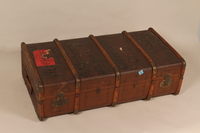
Storage trunk owned by a German Jewish family in hiding
Object
Storage trunk used by the Heppner family to haul possessions in Germany, the Netherlands, and the United States. Albert and Irene Heppner fled Berlin, Germany to Amsterdam, Netherlands, after Adolf Hitler was appointed Chancellor of Germany on January 30, 1933. Albert reestablished his art dealership, and their son, Max, was born later that year. In May 1940, Germany occupied the Netherlands, and established a civilian administration run largely by the SS. The occupying administration gradually tightened control on the residents, and required Jews to register their business assets. Albert’s work permit was rescinded in 1940, but he continued dealing illegally on a small scale. In 1942, the authorities raided their home for valuables on multiple occasions, and began rounding up Jews for deportation in the summer. Albert and his friend, Heinz Graumann, were connected to an underground group who promised to smuggle their families out of the country. They left Amsterdam on August 9, and the smugglers moved them through a series of hiding places. On September 10, the Heppners were placed on a farm owned by Johann (Harry) and Hubertina (Dina) Janssen in Zeilberg-Deurne, where they resided in an empty chicken house. After the Netherlands was liberated in early May, Albert set out to check on his friends and business in Amsterdam. On June 5, Albert suddenly became very ill and died of liver failure. Irene and Max returned to Amsterdam, and lived with friends until their immigration to the United States in November 1946.

British ordnance box given to a German Jewish family in hiding
Object
Metal ordnance box gifted to the Heppner family by Scottish soldier, Charlie Fraser, following the September 1944 liberation of the southern Netherlands. Eleven-year-old Max Heppner became a mascot for the British soldiers that occupied the area near the farm where he had been in hiding. Max wanted an ammunition box that he could use as a lunchbox, but translation miscommunication led Charlie to bring him one that had contained much larger shells. The family used it to store possessions instead. Max was living with his German parents, Albert and Irene, in Amsterdam, when Germany occupied the Netherlands in May 1940. The new civil administration run by the SS gradually tightened control on the residents, and required Jews to register their business assets. Albert’s work permit was rescinded in 1940, but he continued dealing illegally on a small scale. In 1942, the authorities raided their home for valuables on multiple occasions, and began rounding up Jews for deportation in the summer. Albert and his friend, Heinz Graumann, were connected to an underground group who promised to smuggle their families out of the country. They left Amsterdam on August 9, and the smugglers moved them through a series of hiding places. On September 10, the Heppners were placed on a farm owned by Johann (Harry) and Hubertina (Dina) Janssen in Zeilberg-Deurne, where they resided in an empty chicken house. After the Netherlands was liberated in early May, Albert set out to check on his friends and business in Amsterdam. On June 5, Albert suddenly became very ill and died of liver failure. Irene and Max returned to Amsterdam, and lived with friends until their immigration to the United States in November 1946.

Rucksack used by a German Jewish family going into hiding
Object
Rucksack used by a member of the Heppner family while fleeing from Amsterdam and in hiding in the southern Netherlands, from August 1942 until summer 1945. Six-year-old Max Heppner was living with his German parents, Albert and Irene, in Amsterdam, Netherlands, when Nazi Germany invaded in May 1940. The occupying administration gradually tightened control on the residents, and required Jews to register their business assets. Albert’s work permit was rescinded in 1940, but he continued dealing illegally on a small scale. In 1942, the authorities raided their home for valuables on multiple occasions, and began rounding up Jews for deportation in the summer. Albert and his friend, Heinz Graumann, were connected to an underground group who promised to smuggle their families out of the country. They left Amsterdam on August 9, and the smugglers moved them through a series of hiding places. On September 10, the Heppners were placed on a farm owned by Johann (Harry) and Hubertina (Dina) Janssen in Zeilberg-Deurne, where they resided in an empty chicken house. After the Netherlands was liberated in early May, Albert set out to check on his friends and business in Amsterdam. On June 5, Albert suddenly became very ill and died of liver failure. Irene and Max returned to Amsterdam, and lived with friends until their immigration to the United States in November 1946.
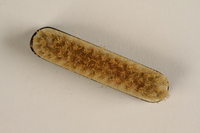
Moustache brush owned by a German Jewish refugee
Object
Silver moustache brush used by Albert Heppner’s father in Germany during the early 20th century. It was likely among the possessions that Albert brought with him when his family went into hiding in the Netherlands in August 1942. Albert and Irene Heppner fled Berlin, Germany, to Amsterdam, Netherlands, after Adolf Hitler was appointed Chancellor of Germany on January 30, 1933. Albert reestablished his art dealership, and their son, Max, was born later that year. In May 1940, Germany occupied the Netherlands, and established a civilian administration run largely by the SS. The occupying administration gradually tightened control on the residents, and required Jews to register their business assets. Albert’s work permit was rescinded in 1940, but he continued dealing illegally on a small scale. In 1942, the authorities raided their home for valuables on multiple occasions, and began rounding up Jews for deportation in the summer. Albert and his friend, Heinz Graumann, were connected to an underground group who promised to smuggle their families out of the country. They left Amsterdam on August 9, and the smugglers moved them through a series of hiding places. On September 10, the Heppners were placed on a farm owned by Johann (Harry) and Hubertina (Dina) Janssen in Zeilberg-Deurne, where they resided in an empty chicken house. After the Netherlands was liberated in early May, Albert set out to check on his friends and business in Amsterdam. On June 5, Albert suddenly became very ill and died of liver failure. Irene and Max returned to Amsterdam, and lived with friends until their immigration to the United States in November 1946.

Shaving brush used by a German Jewish refugee in hiding
Object
Shaving brush used by Albert Heppner while in hiding in the Netherlands, in August 1942. Albert and his wife, Irene, fled Berlin, Germany, to Amsterdam, Netherlands, after Adolf Hitler was appointed Chancellor of Germany on January 30, 1933. Albert reestablished his art dealership, and their son, Max, was born later that year. In May 1940, Germany occupied the Netherlands, and established a civilian administration run largely by the SS. The occupying administration gradually tightened control on the residents, and required Jews to register their business assets. Albert’s work permit was rescinded in 1940, but he continued dealing illegally on a small scale. In 1942, the authorities raided their home for valuables on multiple occasions, and began rounding up Jews for deportation in the summer. Albert and his friend, Heinz Graumann, were connected to an underground group who promised to smuggle their families out of the country. They left Amsterdam on August 9, and the smugglers moved them through a series of hiding places. On September 10, the Heppners were placed on a farm owned by Johann (Harry) and Hubertina (Dina) Janssen in Zeilberg-Deurne, where they resided in an empty chicken house. After the Netherlands was liberated in early May, Albert set out to check on his friends and business in Amsterdam. On June 5, Albert suddenly became very ill and died of liver failure. Irene and Max returned to Amsterdam, and lived with friends until their immigration to the United States in November 1946.

Razor used by a German Jewish man in hiding
Object
Shaving razor used by Albert Heppner while in hiding in the Netherlands, in August 1942. Albert and Irene Heppner fled Berlin, Germany, to Amsterdam, Netherlands, after Adolf Hitler was appointed Chancellor of Germany on January 30, 1933. Albert reestablished his art dealership, and their son, Max, was born later that year. In May 1940, Germany occupied the Netherlands, and established a civilian administration run largely by the SS. The occupying administration gradually tightened control on the residents, and required Jews to register their business assets. Albert’s work permit was rescinded in 1940, but he continued dealing illegally on a small scale. In 1942, the authorities raided their home for valuables on multiple occasions, and began rounding up Jews for deportation in the summer. Albert and his friend, Heinz Graumann, were connected to an underground group who promised to smuggle their families out of the country. They left Amsterdam on August 9, and the smugglers moved them through a series of hiding places. On September 10, the Heppners were placed on a farm owned by Johann (Harry) and Hubertina (Dina) Janssen in Zeilberg-Deurne, where they resided in an empty chicken house. After the Netherlands was liberated in early May, Albert set out to check on his friends and business in Amsterdam. On June 5, Albert suddenly became very ill and died of liver failure. Irene and Max returned to Amsterdam, and lived with friends until their immigration to the United States in November 1946.

Quartz whetstone used by a German Jewish man in hiding
Object
Quartz whetstone used by Albert Heppner while in hiding in the Netherlands, in August 1942. Albert and Irene Heppner fled Berlin, Germany, to Amsterdam, Netherlands, after Adolf Hitler was appointed Chancellor of Germany on January 30, 1933. Albert reestablished his art dealership, and their son, Max, was born later that year. In May 1940, Germany occupied the Netherlands, and established a civilian administration run largely by the SS. The occupying administration gradually tightened control on the residents, and required Jews to register their business assets. Albert’s work permit was rescinded in 1940, but he continued dealing illegally on a small scale. In 1942, the authorities raided their home for valuables on multiple occasions, and began rounding up Jews for deportation in the summer. Albert and his friend, Heinz Graumann, were connected to an underground group who promised to smuggle their families out of the country. They left Amsterdam on August 9, and the smugglers moved them through a series of hiding places. On September 10, the Heppners were placed on a farm owned by Johann (Harry) and Hubertina (Dina) Janssen in Zeilberg-Deurne, where they resided in an empty chicken house. After the Netherlands was liberated in early May, Albert set out to check on his friends and business in Amsterdam. On June 5, Albert suddenly became very ill and died of liver failure. Irene and Max returned to Amsterdam, and lived with friends until their immigration to the United States in November 1946.
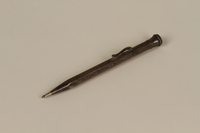
Mechanical pencil used by a German Jewish man in hiding
Object
Mechanical pencil used by Albert Heppner while in hiding in the Netherlands, in August 1942. Albert and Irene Heppner fled Berlin, Germany, to Amsterdam, Netherlands, after Adolf Hitler was appointed Chancellor of Germany on January 30, 1933. Albert reestablished his art dealership, and their son, Max, was born later that year. In May 1940, Germany occupied the Netherlands, and established a civilian administration run largely by the SS. The occupying administration gradually tightened control on the residents, and required Jews to register their business assets. Albert’s work permit was rescinded in 1940, but he continued dealing illegally on a small scale. In 1942, the authorities raided their home for valuables on multiple occasions, and began rounding up Jews for deportation in the summer. Albert and his friend, Heinz Graumann, were connected to an underground group who promised to smuggle their families out of the country. They left Amsterdam on August 9, and the smugglers moved them through a series of hiding places. On September 10, the Heppners were placed on a farm owned by Johann (Harry) and Hubertina (Dina) Janssen in Zeilberg-Deurne, where they resided in an empty chicken house. After the Netherlands was liberated in early May, Albert set out to check on his friends and business in Amsterdam. On June 5, Albert suddenly became very ill and died of liver failure. Irene and Max returned to Amsterdam, and lived with friends until their immigration to the United States in November 1946.

Black leather wallet used by a German Jewish man in hiding
Object
Black leather wallet used by Albert Heppner while in hiding in the Netherlands, in August 1942. Albert and Irene Heppner fled Berlin, Germany, to Amsterdam, Netherlands, after Adolf Hitler was appointed Chancellor of Germany on January 30, 1933. Albert reestablished his art dealership, and their son, Max, was born later that year. In May 1940, Germany occupied the Netherlands, and established a civilian administration run largely by the SS. The occupying administration gradually tightened control on the residents, and required Jews to register their business assets. Albert’s work permit was rescinded in 1940, but he continued dealing illegally on a small scale. In 1942, the authorities raided their home for valuables on multiple occasions, and began rounding up Jews for deportation in the summer. Albert and his friend, Heinz Graumann, were connected to an underground group who promised to smuggle their families out of the country. They left Amsterdam on August 9, and the smugglers moved them through a series of hiding places. On September 10, the Heppners were placed on a farm owned by Johann (Harry) and Hubertina (Dina) Janssen in Zeilberg-Deurne, where they resided in an empty chicken house. After the Netherlands was liberated in early May, Albert set out to check on his friends and business in Amsterdam. On June 5, Albert suddenly became very ill and died of liver failure. Irene and Max returned to Amsterdam, and lived with friends until their immigration to the United States in November 1946.

Knife taken from a German soldier and acquired by a German Jewish family in hiding
Object
Metal knife taken from a German soldier and acquired by a member of Max Heppner’s family in 1944. Max was living with his German parents, Albert and Irene, in Amsterdam, when Germany occupied the Netherlands in May 1940. The new civil administration run by the SS gradually tightened control on the residents, and required Jews to register their business assets. Albert’s work permit was rescinded in 1940, but he continued dealing illegally on a small scale. In 1942, the authorities raided their home for valuables on multiple occasions, and began rounding up Jews for deportation in the summer. Albert and his friend, Heinz Graumann, were connected to an underground group who promised to smuggle their families out of the country. They left Amsterdam on August 9, and the smugglers moved them through a series of hiding places. On September 10, the Heppners were placed on a farm owned by Johann (Harry) and Hubertina (Dina) Janssen in Zeilberg-Deurne, where they resided in an empty chicken house. After the Netherlands was liberated in early May, Albert set out to check on his friends and business in Amsterdam. On June 5, Albert suddenly became very ill and died of liver failure. Irene and Max returned to Amsterdam, and lived with friends until their immigration to the United States in November 1946.
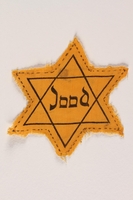
Factory-printed Star of David badge printed with Jood, belonging to a German Jewish refugee
Object
Factory-printed Star of David badge worn by a member of Max Heppner’s family in Amsterdam, Netherlands, after the occupying Nazi administration mandated them on April 28,1942. Max was living with his German parents, Albert and Irene, in Amsterdam, when Germany occupied the Netherlands in May 1940. The new civil administration run by the SS gradually tightened control on the residents, and required Jews to register their business assets. Albert’s work permit was rescinded in 1940, but he continued dealing illegally on a small scale. In 1942, the authorities raided their home for valuables on multiple occasions, and began rounding up Jews for deportation in the summer. Albert and his friend, Heinz Graumann, were connected to an underground group who promised to smuggle their families out of the country. They left Amsterdam on August 9, and the smugglers moved them through a series of hiding places. On September 10, the Heppners were placed on a farm owned by Johann (Harry) and Hubertina (Dina) Janssen in Zeilberg-Deurne, where they resided in an empty chicken house. After the Netherlands was liberated in early May, Albert set out to check on his friends and business in Amsterdam. On June 5, Albert suddenly became very ill and died of liver failure. Irene and Max returned to Amsterdam, and lived with friends until their immigration to the United States in November 1946.
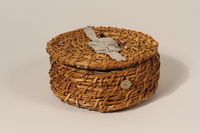
Sewing basket made while in hiding in the Netherlands
Object
Basket and accessories made by Amichai (Max) Heppner from weeds and reeds found on a farm while in hiding in North Brabant, the Netherlands, circa 1943.

Map created by a Dutch Jewish boy while living in hiding
Object
Map created by 10 year old Max Heppner, around 1942-1943, when he was living in hiding with his family on a farm in Holland. Nazi Germany occupied the Netherlands in May 1940. Max and his family lived in Amsterdam and in 1942, after house raids and the confiscation of his father's art business, they attempted to flee to France. The Dutch underground placed the family with another Jewish family on a farm. They lived mostly in chicken houses where the farmer built special hiding places and gave them a radio. The area was liberated in September 1944. Max and his mother emigrated to the United States on November 4, 1946.

Map created by a Dutch Jewish boy while living in hiding
Object
Map created by 10 year old Max Heppner, around 1942-1943, when he was living in hiding with his family on a farm in Holland. Nazi Germany occupied the Netherlands in May 1940. Max and his family lived in Amsterdam and in 1942, after house raids and the confiscation of his father's art business, they attempted to flee to France. The Dutch underground placed the family with another Jewish family on a farm. They lived mostly in chicken houses where the farmer built special hiding places and gave them a radio. The area was liberated in September 1944. Max and his mother emigrated to the United States on November 4, 1946.
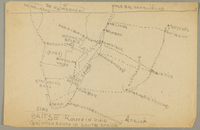
Map created by a Dutch Jewish boy while living in hiding
Object
Map created by 10 year old Max Heppner, around 1942-1943, when he was living in hiding with his family on a farm in Holland. Nazi Germany occupied the Netherlands in May 1940. Max and his family lived in Amsterdam and in 1942, after house raids and the confiscation of his father's art business, they attempted to flee to France. The Dutch underground placed the family with another Jewish family on a farm. They lived mostly in chicken houses where the farmer built special hiding places and gave them a radio. The area was liberated in September 1944. Max and his mother emigrated to the United States on November 4, 1946.

Map created by a Dutch Jewish boy while living in hiding
Object
Map created by 10 year old Max Heppner, around 1942-1943, when he was living in hiding with his family on a farm in Holland. Nazi Germany occupied the Netherlands in May 1940. Max and his family lived in Amsterdam and in 1942, after house raids and the confiscation of his father's art business, they attempted to flee to France. The Dutch underground placed the family with another Jewish family on a farm. They lived mostly in chicken houses where the farmer built special hiding places and gave them a radio. The area was liberated in September 1944. Max and his mother emigrated to the United States on November 4, 1946.

Map created by a Dutch Jewish boy while living in hiding
Object
Map created by 10 year old Max Heppner, around 1942-1943, when he was living in hiding with his family on a farm in Holland. Nazi Germany occupied the Netherlands in May 1940. Max and his family lived in Amsterdam and in 1942, after house raids and the confiscation of his father's art business, they attempted to flee to France. The Dutch underground placed the family with another Jewish family on a farm. They lived mostly in chicken houses where the farmer built special hiding places and gave them a radio. The area was liberated in September 1944. Max and his mother emigrated to the United States on November 4, 1946.

Map of Eastern Europe and the Middle East owned by a Dutch Jewish boy while living in hiding
Object
Map owned by 10 year old Max Heppner, around 1942-1943, when he was living in hiding with his family on a farm in Holland. Nazi Germany occupied the Netherlands in May 1940. Max and his family lived in Amsterdam and in 1942, after house raids and the confiscation of his father's art business, they attempted to flee to France. The Dutch underground placed the family with another Jewish family on a farm. They lived mostly in chicken houses where the farmer built special hiding places and gave them a radio. The area was liberated in September 1944. Max and his mother emigrated to the United States on November 4, 1946.
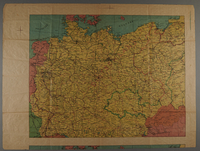
Map of Germany owned by a Dutch Jewish boy while living in hiding
Object
Map owned by 10 year old Max Heppner when he was living in hiding with his family on a farm in Holland from 1942-1944. Nazi Germany occupied the Netherlands in May 1940. Max and his family lived in Amsterdam and in 1942, after house raids and the confiscation of his father's art business, they attempted to flee to France. The Dutch underground placed the family with another Jewish family on a farm. They lived mostly in chicken houses where the farmer built special hiding places and gave them a radio. The area was liberated in September 1944. Max and his mother emigrated to the United States on November 4, 1946.
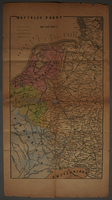
Map of the Western Front in Europe owned by a Dutch Jewish boy while living in hiding
Object
Map owned by 10 year old Max Heppner when he was living in hiding with his family on a farm in Holland from 1942-1944. Nazi Germany occupied the Netherlands in May 1940. Max and his family lived in Amsterdam and in 1942, after house raids and the confiscation of his father's art business, they attempted to flee to France. The Dutch underground placed the family with another Jewish family on a farm. They lived mostly in chicken houses where the farmer built special hiding places and gave them a radio. The area was liberated in September 1944. Max and his mother emigrated to the United States on November 4, 1946.

Map of the Eastern front in Europe owned by a Dutch Jewish boy while living in hiding
Object
Map owned by 10 year old Max Heppner when he was living in hiding with his family on a farm in Holland from 1942-1944. Nazi Germany occupied the Netherlands in May 1940. Max and his family lived in Amsterdam and in 1942, after house raids and the confiscation of his father's art business, they attempted to flee to France. The Dutch underground placed the family with another Jewish family on a farm. They lived mostly in chicken houses where the farmer built special hiding places and gave them a radio. The area was liberated in September 1944. Max and his mother emigrated to the United States on November 4, 1946.

Map of the Far East owned by a Dutch Jewish boy while living in hiding
Object
Map owned by 10 year old Max Heppner when he was living in hiding with his family on a farm in Holland from 1942-1944. Nazi Germany occupied the Netherlands in May 1940. Max and his family lived in Amsterdam and in 1942, after house raids and the confiscation of his father's art business, they attempted to flee to France. The Dutch underground placed the family with another Jewish family on a farm. They lived mostly in chicken houses where the farmer built special hiding places and gave them a radio. The area was liberated in September 1944. Max and his mother emigrated to the United States on November 4, 1946.
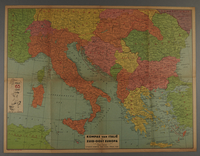
Map of Italy and Southeast Europe owned by a Dutch Jewish boy while living in hiding
Object
Map owned by 10 year old Max Heppner when he was living in hiding with his family on a farm in Holland from 1942-1944. Nazi Germany occupied the Netherlands in May 1940. Max and his family lived in Amsterdam and in 1942, after house raids and the confiscation of his father's art business, they attempted to flee to France. The Dutch underground placed the family with another Jewish family on a farm. They lived mostly in chicken houses where the farmer built special hiding places and gave them a radio. The area was liberated in September 1944. Max and his mother emigrated to the United States on November 4, 1946.

Map of France owned by a Dutch Jewish boy while living in hiding
Object
Map owned by 10 year old Max Heppner when he was living in hiding with his family on a farm in Holland from 1942-1944. Nazi Germany occupied the Netherlands in May 1940. Max and his family lived in Amsterdam and in 1942, after house raids and the confiscation of his father's art business, they attempted to flee to France. The Dutch underground placed the family with another Jewish family on a farm. They lived mostly in chicken houses where the farmer built special hiding places and gave them a radio. The area was liberated in September 1944. Max and his mother emigrated to the United States on November 4, 1946.
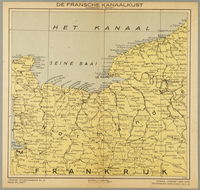
Map of the canal network in France owned by a Dutch Jewish boy while living in hiding
Object
Map owned by 10 year old Max Heppner when he was living in hiding with his family on a farm in Holland from 1942-1944. Nazi Germany occupied the Netherlands in May 1940. Max and his family lived in Amsterdam and in 1942, after house raids and the confiscation of his father's art business, they attempted to flee to France. The Dutch underground placed the family with another Jewish family on a farm. They lived mostly in chicken houses where the farmer built special hiding places and gave them a radio. The area was liberated in September 1944. Max and his mother emigrated to the United States on November 4, 1946.
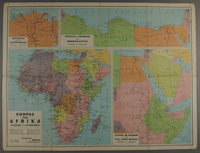
Map of Africa owned by a Dutch Jewish boy while living in hiding
Object
Map owned by 10 year old Max Heppner when he was living in hiding with his family on a farm in Holland from 1942-1944. Nazi Germany occupied the Netherlands in May 1940. Max and his family lived in Amsterdam and in 1942, after house raids and the confiscation of his father's art business, they attempted to flee to France. The Dutch underground placed the family with another Jewish family on a farm. They lived mostly in chicken houses where the farmer built special hiding places and gave them a radio. The area was liberated in September 1944. Max and his mother emigrated to the United States on November 4, 1946.
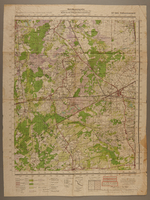
Map of ground installations of an area of North Brabant taken from a German soldier
Object
Taken from German soldier, circa 1941.
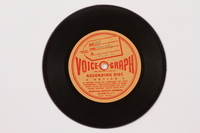
Voice-O-Graph vinyl record and envelope
Object
Voice-O-Graph vinyl record and mailing envelope from Max Heppner to the Burbach family in Amsterdam-West, Holland. The record was designed to be a voice-recording alternative to written correspondence.

Voice-O-Graph vinyl record and envelope
Object
Voice-O-Graph vinyl record with blank mailing envelope. The record was designed to be a voice-recording alternative to written correspondence.
Blanket owned by a German Jewish woman fleeing Germany
Object
Travel blanket used by Irene Heppner while emigrating from Berlin, Germany, to Amsterdam, Netherlands, in June 1933. She sewed money into the blanket and brought it with her on the train. Irene and her husband, Albert, fled Berlin after Adolf Hitler was appointed Chancellor of Germany on January 30, 1933. Albert reestablished his art dealership, and their son, Max, was born later that year. In May 1940, Germany occupied the Netherlands, and established a civilian administration run largely by the SS. The occupying administration gradually tightened control on the residents, and required Jews to register their business assets. Albert’s work permit was rescinded in 1940, but he continued dealing illegally on a small scale. In 1942, the authorities raided their home for valuables on multiple occasions, and began rounding up Jews for deportation in the summer. Albert and his friend, Heinz Graumann, were connected to an underground group who promised to smuggle their families out of the country. They left Amsterdam on August 9, and the smugglers moved them through a series of hiding places. On September 10, the Heppners were placed on a farm owned by Johann (Harry) and Hubertina (Dina) Janssen in Zeilberg-Deurne, where they resided in an empty chicken house. After the Netherlands was liberated in early May, Albert set out to check on his friends and business in Amsterdam. On June 5, Albert suddenly became very ill and died of liver failure. Irene and Max returned to Amsterdam, and lived with friends until their immigration to the United States in November 1946.
Carved upright wooden bench owned by Jakob Krämer and the Heppner family
Object
Large, handcrafted wooden bench with storage space made in 1911, in Munich Germany, and owned by Irene Heppner’s father, Jakob Krämer. The bench was brought with the family when they fled to Amsterdam, Netherlands in 1933. It was occasionally used as a hiding place during the Nazi occupation, and was one of the few things remaining in their apartment after the war. Irene and Albert Heppner fled Berlin, Germany, to Amsterdam, Netherlands, after Adolf Hitler was appointed Chancellor of Germany on January 30, 1933. Albert reestablished his art dealership, and their son, Max, was born later that year. In May 1940, Germany occupied the Netherlands, and established a civilian administration run largely by the SS. The occupying administration gradually tightened control on the residents, and required Jews to register their business assets. Albert’s work permit was rescinded in 1940, but he continued dealing illegally on a small scale. In 1942, the authorities raided their home for valuables on multiple occasions, and began rounding up Jews for deportation in the summer. Albert and his friend, Heinz Graumann, were connected to an underground group who promised to smuggle their families out of the country. They left Amsterdam on August 9, and the smugglers moved them through a series of hiding places. On September 10, the Heppners were placed on a farm owned by Johann (Harry) and Hubertina (Dina) Janssen in Zeilberg-Deurne, where they resided in an empty chicken house. After the Netherlands was liberated in early May, Albert set out to check on his friends and business in Amsterdam. On June 5, Albert suddenly became very ill and died of liver failure. Irene and Max returned to Amsterdam, and lived with friends until their immigration to the United States in November 1946. The bench was sent to Max as a wedding gift after he married in 1958.
Max Amichai Heppner papers
Document
The Max Amichai Heppner papers consist of address books and calendars, correspondence, lessons and notes, personal and travel narratives, photographs, printed materials, scrapbooks titled “Remembrance of the Holocaust,” subject files, and writings documenting the Heppner family from Berlin, their prewar refuge in Amsterdam, their wartime refuge on Harry and Dina Janssen’s farm, their liberation, their immigration to the United States, and their efforts to assist and publicly recognize the Janssen family. Address books and calendars include wartime calendars and address books used by the Heppner family to keep track of friends and family members and to note important events. Correspondence primarily consists of letters exchanged between Irene Heppner in Ohio and Ans and Frans Burbach in the Netherlands after the war exchanging news and handling ongoing financial and legal matters. This series also includes correspondence with relatives and friends in England and the United States after liberation describing wartime experiences, liberation, plans for future, and news of Albert’s death in 1945. Lessons and notes include a notebook containing Max Heppner’s English lessons in the front and personal narratives in Dutch and English about the Heppner family’s hiding and liberation in the back; loose pages of notes and lessons from the notebook; a coloring book containing poems and drawings; pages of song lyrics and notes (many of which are hand-illustrated) that had been kept inside the coloring book; Albert Heppner’s notes about the meanings of certain German abbreviations; a handmade Dutch-German dictionary; and an empty pad of paper whose cover Albert Heppner had decorated. These records document Max Heppner’s continued education in hiding as well as the family’s use of the German, Dutch, and English languages. Personal and travel narratives include Albert’s description of his early life, Hitler’s rise to power, antisemitism, and the German occupation of the Netherlands. This series also includes travel narratives describing Ans and Frans Burbach’s trips to France, Italy, and the United States after the war. Photographs depict Max Heppner, his parents, and their friends and also include a portfolio of photographs of artwork by Rembrandt and Adriaen Brouwer that Albert Heppner created for a comparative study. Printed materials primarily consist of maps Max Heppner clipped out of German, English, and Dutch language newspapers for study. This series also includes advertisements taken out by the Heppner family in Dutch newspapers thanking the Janssen family for their protection during the Holocaust and bidding their friends farewell as they left for America as well as a copy of the June 2, 1945 issue of Ons Vrije Nederland. Max Heppner created his scrapbook in fifteen sections that are roughly chronological and thematic. The sections retain titles Heppner’s original titles. “The Shadow of Hitler” includes Albert Heppner’s doctoral degree certificate, photocopies of an art history article by Heppner and Max Heppner’s birth certificate, postcards depicting Amsterdam, a 1918 military document, illustrated letters and poems by Albert Heppner, Albert and Irene Heppner’s wedding menu, ration books, and a satirical recipe based on ration coupons. “Persecution” includes a clipping showing a map and a brief timeline of the Holocaust, illustrated notes and letters, correspondence with family in Ohio about plans to emigrate, a photograph and letter about Albert Heppner’s art business, and an identification card and certificate related to Albert Heppner’s participation in the Jewish Council. “Flight and in Hiding” includes a New Year’s card, a Red Cross form letter from Frans Burbach, an English lesson, and an illustrated note. “Poems in Hiding” includes poems written by members of the Heppner, Graumann, and Janssen families while the Heppner family was hiding on the Janssen farm. “Liberation” includes a safe conduct flier air-dropped by the Allies, German and Dutch scrip and currency, clippings of maps, ration tickets, and notes. “Remergence” includes a description of a dream Max had, Dutch registration certificates, and correspondence with family members and friends. “New Work Attempt” includes correspondence document Albert Heppner’s efforts to restart his career. “Reconnections” includes a clipping about the death of the Graumann’s son, a photocopy of an advertisement about Germany’s capitulation in Holland, Albert Heppner’s correspondence with friends, and certificates documenting the good conduct and trustworthiness of the Heppner family. “Last Journey” includes correspondence, certificates, and notes documenting the death of Albert Heppner as well as school records documenting Max Heppner’s continued education in Amsterdam.
Book
Object




